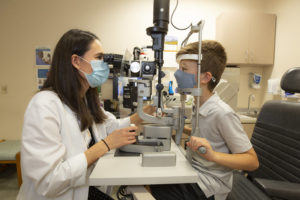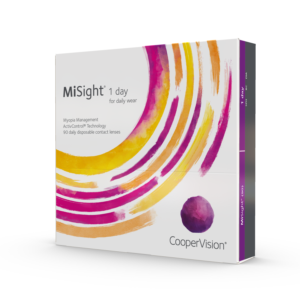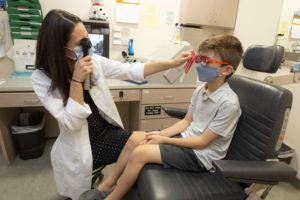sponsored content
November 15, 2022
Today, the pediatric myopia clinic is spearheaded by a team of three ODs and dedicated staff who work to identify and treat myopia as early as possible and offer the latest treatments that show promise for slowing progression.

Pediatric optometrist Yos M. Priestley, OD, examines a patient’s eyes at Duke Eye Center. Photo credit: Erin Hull, Duke Health
When the team at Duke Eye Center in Durham, North Carolina, recently launched their pediatric myopia clinic in October 2021, their decision behind the creation of this clinic-within-a-clinic was influenced by not one, but numerous factors, including breakthrough research that has offered a greater understanding of the condition, the advent of new treatments to slow progression, and the need to incorporate longer appointments for myopia visits in an already busy clinic schedule.
Today, the pediatric myopia clinic is spearheaded by a team of three ODs and dedicated staff who work to identify and treat myopia as early as possible and offer the latest treatments that show promise for slowing progression. Yet another reason for the myopia clinic’s success is the support from the Eye Center’s ophthalmologists.
“Myopia management has generally become well accepted, and we’ve been offering it for quite a while, but as more research has been published, and we’ve continued to review the newer literature with the ophthalmologists in our group, they’ve been very supportive of myopia as a treatment option for patients,” explained Duke Eye Center pediatric optometrist Yos Priestley, OD.
In turn, optometrists have become a vital information source by sharing which children would be good candidates for myopia control with the Eye Center’s MDs.
“The ophthalmologists have been very supportive in referring patients to us and letting us lead in that zone,” she said. “When we have faculty meetings, we have discussions with our colleagues about our clinic. It’s been a good back-and-forth collaborative, and we often send our high myopes back to the ophthalmologists for retinal management, so it’s really a team effort.”
MDs at Duke Eye Center echo this sentiment. “Pediatric myopia control has become the standard of care, and we’re pleased to offer a comprehensive approach with various treatment options in our myopia control clinic,” said Dr. Laura Enyedi, an ophthalmologist at Duke Eye Center and professor of ophthalmology and pediatrics at Duke University.
Building a Strong Framework
Duke Eye Center devotes one day a month to the pediatric myopia clinic, and Dr. Priestley and her two fellow optometrists at the center take turns overseeing the patients on a rotating basis. One aspect that’s unique about Duke Eye Center’s approach: The myopia consult, required testing, and any contact lens fitting are all done during a single appointment.
“We found this to be a better approach than trying to educate the child and parent in the main clinic and then have them return for numerous appointments,” said Dr. Priestley.
Education Starts on Day One
Initial myopia education generally starts at the Eye Center. Once Dr. Enyedi identifies a patient who presents with significant progression or progression risk, she explains the long-term risks of myopia and briefly reviews myopia control options.
“I give written information on myopia control and refer the child to the Duke myopia control clinic so the parents can choose the best option for their child with expert guidance from our pediatric optometrists,” Dr. Enyedi explains.
This initial communication provides patients and parents a general idea of the myopia control process and motivates them to pursue a treatment plan by the time they arrive at the myopia control clinic, according to Dr. Priestly.
At the first myopia control clinic visit, Dr. Priestley and her team will stress the importance of behavior modifications, visual hygiene, time spent outdoors, and good lighting for the child when reading. The myopia clinic optometrists communicate these points to all children with myopia, even if they are a -0.50D. Additionally, this information will be shared with children who are emmetropic but have myopic parents, which places them at greater risk.
During the myopia discussion, Dr. Priestley avoids scare tactics when describing progression and its potential consequences. For example, she may explain that the child’s prescription progressed from -1.00D to -2.00D since the last visit, which means the eyes are getting longer, and over time this can cause other complications because of the stretch of the retina.
“I’ll then share the treatment options available to slow down the progression as much as possible,” Dr. Priestley added.
Communicating Options
Most children who are patients at Duke’s pediatric myopia clinic are 8-10 years old, their myopia has progressed, and they were previously prescribed glasses for vision correction.
“These patients and their families are already aware of myopia control since we give every patient a myopia packet when they come in for their first visit and new glasses. In many cases, these children’s prescriptions have progressed within six months and even before a full year has passed,” Dr. Priestley said.
 The myopia clinic offers low-dose atropine, multifocal lens options, and CooperVision MiSight 1 day* dual-focus soft contact lenses as treatment options for age-appropriate patients. “I’ve had so much success with myopia either slowing down considerably or halting entirely, although, of course, this isn’t true with every patient,” she said.
The myopia clinic offers low-dose atropine, multifocal lens options, and CooperVision MiSight 1 day* dual-focus soft contact lenses as treatment options for age-appropriate patients. “I’ve had so much success with myopia either slowing down considerably or halting entirely, although, of course, this isn’t true with every patient,” she said.
Overall, families have been happy with the treatment results. “Every child is different and responds differently to treatment, but we do everything we can to slow myopia progression as much as possible,” said Dr. Priestley.
Sustaining a Strong Partnership
As the one-year anniversary of the myopia control clinic nears, support from the ophthalmologists at Duke Eye Center is helping to fuel its success, and in turn, making a difference in children’s lifetime vision and eye health.
“I’m so pleased that Dr. Priestley and her team have started this program as a resource both for our patients and our eye care team so that families have access to in-depth counseling and cutting-edge myopia treatments,” said Dr. Enyedi.
Lessons Learned from the Trenches
For those optometrists just starting in myopia control, Dr. Priestley suggests keeping in mind these key considerations:
- Stay up to date with the latest research. What is currently understood about myopia today is much different from what we knew about it five years ago.
- Communicate early and often. Patient education is critical, and the more times you present it, the better prepared the families will be when they come in for their follow-up with you, so they can ask any questions they have, and you won’t be starting from scratch.
- Get your staff on-board. Educating your staff is as important as educating parents. One simple example is to explain to staff why it’s important to check axial length at the follow-up visit.
- Build longer myopia appointments into your schedule. Myopia control takes more chair time than you might expect. You need to give yourself enough time for education and to allow families enough time to ask questions.”
*U.S. Indications for Use: MiSight 1 day (omafilcon A) soft (hydrophilic) contact lenses for daily wear are indicated for the correction of myopic ametropia and for slowing the progression of myopia in children with non-diseased eyes, who at the initiation of treatment are 8-12 years of age and have a refraction of -0.75 to 4.00 diopters (spherical equivalent) with ≤ 0.75 diopters of astigmatism. The lens is to be discarded after each removal.














